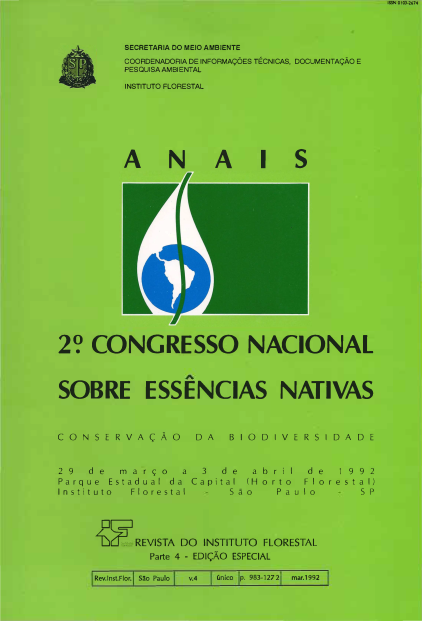EDUCAÇÃO AMBIENTAL EM FLORESTAS - O PROJETO PIC-NIC NA FLORESTA, NA DURAFLORA S.A.
DOI:
https://doi.org/10.24278/2178-5031.199244718Keywords:
Environmental education, ecological trails, social forest multiple useAbstract
DURATEX'S Environmental Education Program comprehends many lines of work. One of them is the PIC NIC NA FLORESTA Project. The main objectives of the project are: 1) to awaken the affection of children in relation to the nature, in a spontaneous and cheerful manner; to permit the children to discover by themselves that the forest is a pleasant place, leave them free to exercise their creativity; 2) to participate in the development of environmental education, making good use of the company's natural property, where forestry reserves, natural and implanted, have landscapes of uncommon beauty and to protect many animal and vegetation species, one of these in extinction. The methodology utilized included ecological trails, a different concept to the interpretative trails, where the child rediscovers nature, not with the previous orientation of signs, arrows and other auxiliary matérials. Thirty children were conducted by two university students and one assistant, in trips with eight hours average duration, on Saturdays and Sundays, thrciughout several contexts, such as riparian forests, home gardens, native planted forests, native forests, different geological sites, Eucalyptus forests, Pinus forests, dams, rivers, lakes, rural constructions, natural history museum, soccerfields, seedling nursery, schools, church and others. Psychopedagogic assistance was provided. Toys or instruments were not used, but were prepared with natural materiais. During the trips, there were three basic rules: 1) Don'fleave refuse in the trails other than rapidly biodegradables; 2) Don't carry anything off the trails; 3) To walk near to the leader and to the group. Gifts were provided (backpack, cap, notebook, pencil with eraser, wax chalk box, prompter). Transports, meals and identification cardswere also provided.lnsurance was taken out for each person. At the end of trip, a tree was planted.
Downloads
References
ALLEN, R."H. Children and Nature. American Forests. Washington, 82 (4): 24-7; 64-6, 1976.
DAVIES, R. E. People and Forests. Petawawa National Forestry Institute, Canadian Forestry Service. Information National Forestry Institute, 1985. 30p. HARTMANN, L. A. Spontaneous interpretation. Journal of Interpretation, 9 (1)33-8, 1984. '., HOPE, J. M. Conscientizar para Preservar a Natureza: " através da educação em escolas de 12e 22graus. In: CONGRESSO FLORESTAL ESTADUAL, 5. Nova Prata/RS, 1984. Anais, p.172-179.
ITCF. Programa de EducaçãoAmbiental.ITCF, Curitiba, 1986. p17.
MACFARLAND, C. Esquema de La Metodolgia para La Preparacion de Planes de Interpretaccion y Educacion Ambiental de Areas Silvestres. CATIE. Dept. de Recursos Naturales Renovables. Turrialba, 1982. 6 p.
MACHADO, A. B. M. Educação Conservacionista. In: CONGRESSO ESTADUAL DE EDUCAÇÃO ECOLÓGICA. 12. Ibirubá, RS, 03-05/10/84. Anais. O ASPECTO Econômico da Proteção ao Meio Ambiente. Economic Impact 3(65), 1989. Ed. em português, 81 p.
SCHENKEL, H. F. Planejamento de Caminhadas e Programas Ecológicos. ITCF. Depto. de Recursos Naturais Renováveis. Curitiba, 1986. 13 p.
STOCKING, M. A. Educação Ambiental através da demonstração dos fatores erosivos e suas características. (trad. Ruth FerrazdoAmaral). Brasília, SNAP, 1986.25 p.
















